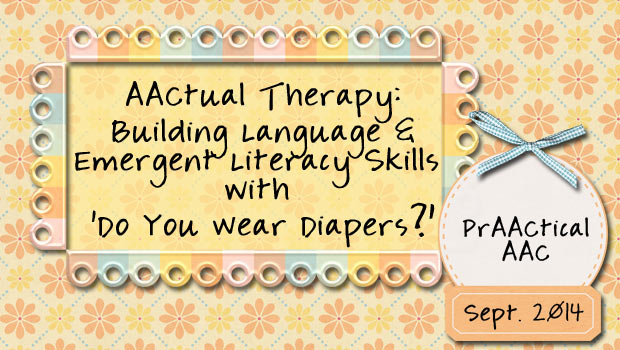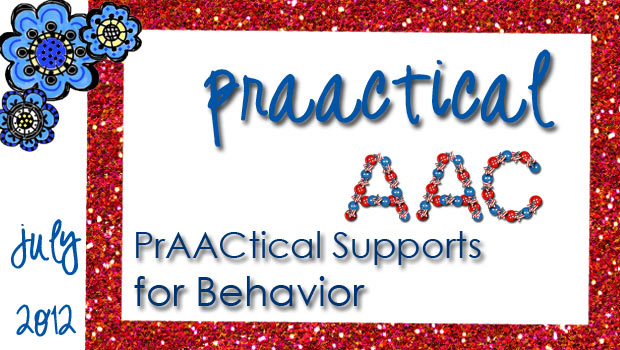How I Do It with Kimberly Scanlon: Using Visual Supports to Build Attention and Cooperation
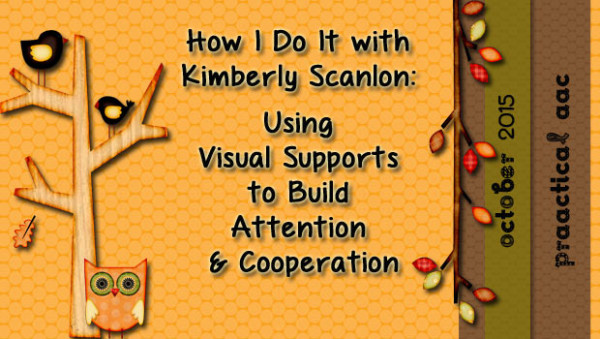
Having solid goals and fun activities is one thing, but being able to connect the two and teach communication and language takes skill. We  have the best outcomes when the interventionist knows a variety of strategies that can support the learning outcomes. We’ve written about implementing countdown boards and other visual supports to build attention in the past, and have been gratified to hear from many of you who utilize those strategies. In today’s post, SLP Kimberly Scanlon, owner of Scanlon Speech Therapy, discusses how she implements this strategy and shares her own clever variation. You can download it at the end of the post.
have the best outcomes when the interventionist knows a variety of strategies that can support the learning outcomes. We’ve written about implementing countdown boards and other visual supports to build attention in the past, and have been gratified to hear from many of you who utilize those strategies. In today’s post, SLP Kimberly Scanlon, owner of Scanlon Speech Therapy, discusses how she implements this strategy and shares her own clever variation. You can download it at the end of the post.
::::::::::::::::::::::::::::::::::::::::::::::::::::::::::::::::::
You plan the session. In fact, you over-plan and over prepare. You carefully select materials ensuring they are appropriate, engaging, and motivating for the client. Each activity will be short. Short is key as this student grows restless and losses interest rather quickly. You remove most of the distractors (can’t remove the fan or the light switch) to ensure that he will focus on this amazing game meticulously designed with some inspiration from Pinterest, of course. The moment comes and the student arrives.
He. Is. Engaged. Yay!!
5 minutes and several turns pass and you sense it.
He is beginning to lose interest. His attention is waning. Panic sets in.
What do you do?
Options:
- Keep telling him – “Let’s just do a little bit more.”
- Tell him – “It makes me really happy when you listen and take turns.”
- Decide to follow his lead and forget about encouraging him to take one more turn. After all, the experts say to follow the child’s lead.
Ah, but there are more options. Here’s one that involves 2 things:
- Set clear expectations
- Use visuals
Setting clear expectations helps to decrease frustration and inattention. When there is an understanding of what to do and knowledge of when a task or activity will end, the child can anticipate the conclusion. And, when the child knows when an activity concludes, he or she will more likely spend his or her time attending to the task at hand.
Before you sense the child is losing interest, tell and show the child how much more you want him or her to accomplish, participate, or do.
Set clear expectations by telling the child:
- “One more piece then we’re all done.”
- “One more turn then we’re all done.”
Pediatric speech therapist, Laura Mize, is a believer in this strategy and calls it “The One More Rule”.
Many children, though, need more than the verbal explanation to get it. This is when visuals or mini-schedules come in handy.
Recently, I completed an AMAZING online workshop titled, Visual Systems: Practical Communication Supports by speech language pathologist, Lorraine Maida. I HIGHLY recommend it if you’re interested in learning more about how to use visuals to support language learning with your students, clients, children. In her presentation, she shared so many nuggets of wisdom including:
“When a child has more information he or she will be more cooperative.”
“Less talk and more showing.”
“Always start with the end in mind.”
After completing Maida’s workshop, I turned on my computer and made the following visuals:
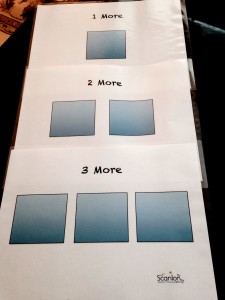
I made a One More visual, a Two More visual, and a Three More visual. The Two and Three More visuals were designed for my clients with stronger attention spans. For instance, if we’re playing a game and I sense that the client is becoming restless, I’ll take out the visual and say, “You’ll take 3 more turns and then put the game away.”
I use the One More visual with my toddlers or clients who struggle to stay on task for short periods or quickly move from task to task. If I say, “Let’s do one more”, I simultaneously show the child the visual while saying the command. For instance, if we are doing a puzzle and he sees something else that strikes his fancy, I will say, “Let’s do one more piece” and show my visual.
Laminating the visuals allows me to use a marker and make an X or check mark after completion.
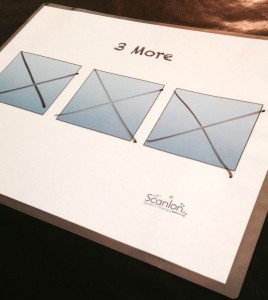 So far, this visual system has worked well for me. I intend to improve it by shrinking each visual to the size of a standard index card, joining all three together with a key chain ring and, attaching them to lanyard.
So far, this visual system has worked well for me. I intend to improve it by shrinking each visual to the size of a standard index card, joining all three together with a key chain ring and, attaching them to lanyard.
I’ll end with one piece of advice…
If you promise the task will be completed in one, two, or three turns then keep your promise and end the task. As a clinician or parent it’s tempting to keep it going and going and going but don’t make yourself into a liar! If you keep your word, the child will really believe you when you say, “Just one more!”
Click here to download my visuals for your own use. If you have more ideas, please comment below!! Hope this has been helpful.
::::::::::::::::::::::::::::::::::::::::::::::::::::::::::::
Kimberly Scanlon, M.A. CCC-SLP is a speech language pathologist, an author and a mother. As the owner of Scanlon Speech Therapy, LLC, a unique boutique practice in Bergen County, Kimberly embraces individuality and treats the whole person. Her goal is to spread compassion, hope, and some speech, language and literacy tips one moment, one person at a time. Her first book, My Toddler Talks: Strategies and Activities to Promote Your Child’s Language Development and her second book, Learning to Read is a Ball are available for purchase online at Amazon and Barnes and Noble.
Filed under: PrAACtical Thinking
Tagged With: attention, countdown board, Kimberly Scanlon
This post was written by Carole Zangari


